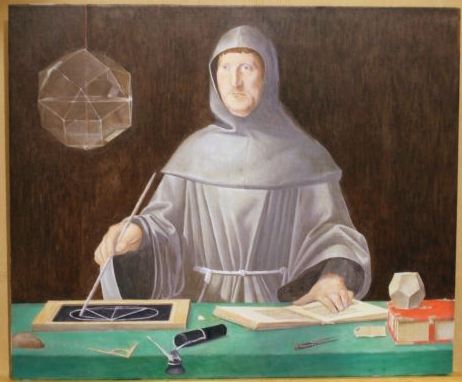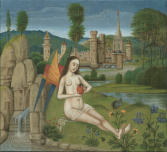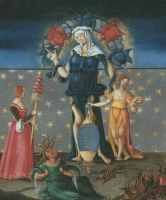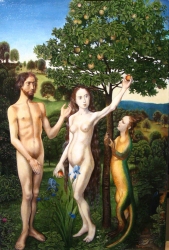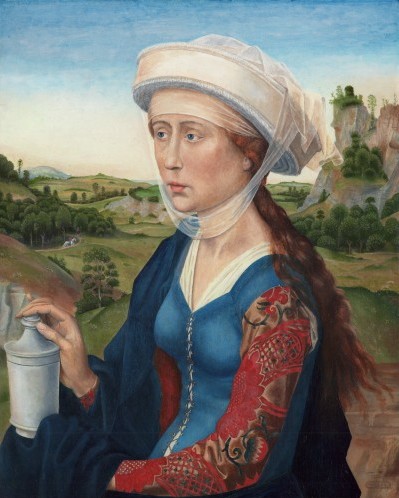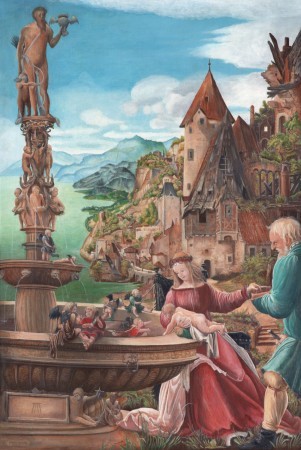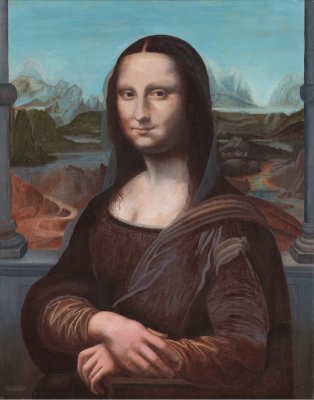In 2004 I decided to make facsimilies of some Flemish illuminated manuscripts which I particularly admired - an image of Pan with his pipes, an image of the soul, and the three Fates.
I sold two of these quite quickly, and I decided to try making copies of some early paintings. Firstly, I made a painting of a section from Bosch's Garden of Earthly Delights (the lovers in the flower sphere), and later I worked on an elaborate image of the fountain in the garden of Venus from the De Sphaera manuscript. Having found myself able to create detailed copies of these works, I embarked on the most ambitious work I had then made - the Temptation of Hugo van der Goes. When I started on this I was unsure if I could manage to do this work justice, but I just kept at it and after many, many hours I was able to produce a good copy. I will likely keep this in my collection as it marked a significant development in my work. You can see some close up detail on this page.
Having become more confident in tackling an Old Master such as Hugo van der Goes, I turned my attention to some other early painting that I much admired. After an abortive attempt at the Flemish Love Spell, which I had made a bit too small so that the detail proved too challenging, I made a facsimile at a larger size and this worked out well. The Rogier van der Weyden was especially delightful to do. The original suffered from much craqueleure so I enjoyed making a good copy. The background landscape was a great delight as was the texture of the Magdelene's sleeve. The Altdorfer had such a wonderful backdrop of tumbled village set on a hillside that I just wanted to see if I could paint it. These were completed in 2009.
The problem with making these facsimiles is that I find them impossible to part with ! Even after three years I am still delighted by seeign these works on thwe wall of my study room and am not yet ready to sell them. Unfortunately, I have not been able to work on any further Old Masters, despite my having collected a great deal of material to work with. I have at least 20 paintings of which I would like to produce copies.
Usually I make an exact copy of the original without adding anything of my own, except to patch up areas where the original had become damaged. In the case of a painting I have admired for years because of its amazing depiction of a complex three dimensional polyhedron, I did make a definite change. This painting by the Italian Jacopo de Barbari (ca.1440-1515), now in the Palace of Capodimonte in Naples, entitled A Portrait of Luca Pacioli, was made in 1495. The painting of the polyhedron always fascinated me. It is a rhombicuboctahedron, an Archimedean solid with eight triangular and eighteen square faces, here it appears to be made of glass and also half filled with water. The figure in this painting is the Franciscan friar Luca Pacioli (1445 - 1514) who had a great interest in geometry and wrote some books on the subject. I am amazed at the painting of the polyhedron which needed a deep understanding of perspective as well as reflection in the transparent medium. Some historians suppose that Barbari enlisted the help of Leonardo da Vinci. So I decided that painting that polyhedron would be a considerable challenge. I always found the original painting was spoiled by the young popinjay on the left, probably the son of the person who commissioned the painting. I wanted to focus on the wise old mathematician and the polyhedron so I just left the young man out of my copy.

